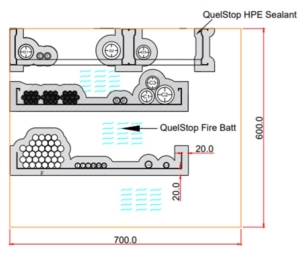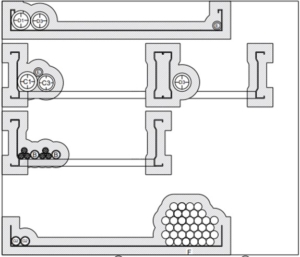Test standard updates: Do older standards get superseded? Tested Detail Queries
Please note that the term ‘superseded’ means ‘replaced’.
The simple answer is no; when test standards are updated, older standards are still valid but have limitations. Let’s explore this a little bit further with real-life examples.
The BS EN 1366 fire-resistance test standard for service penetrations was updated in December 2021 from its 2009 version. This update raised questions and concerns about the validity of fire test evidence tested to the 2009 version compared to the 2021 revision.
Realistically, if all test evidence was deemed non-compliant before 2021, the construction industry would grind to a halt as there would be no feasible way to promptly fire test all applications again. Therefore, test evidence from an older standard is generally valid, provided it does not contradict anything in the latest update.
At Quelfire, our products are consistently reclassified to include new scope of application. The accredited organisation that creates this documentation will use all the available fire test evidence from the 2009 and 2021 standards to confirm what can/cannot be used, including the potential limitations.
One of the changes from 2009 to 2021 was how we fire test cables and cable carriers. Typically, manufacturers fire tested what is known as the full cable configuration to the 2009 standard:

This included different cable carriers, certain cable types, and small 16mm conduits. The 2021 version changed the cable configuration (see below) to provide more flexible solutions and a wider field of application. The 16mm conduits were also removed, and conduits now have a dedicated section within the BS EN 1366-3 standard Annex C.

Although the cable configuration has changed, older evidence is not invalid; it’s just limited to the field-of-application guidelines in the older version.
A clear example of this is shown in detail QB-FW100-D-02. Page one of the detail shows the full cable configuration tested to the 2009 version, while page two shows testing to 2021. Although the cable carriers fire tested were the same size, those tested to the 2021 test standard have a more extensive scope of application, allowing an unlimited size for the carriers. In contrast, the 2009 test evidence is limited to the sizes tested or less.
You can also see that page one includes 16mm conduits, but page two doesn’t. As mentioned earlier, the updated standard now has a dedicated section for conduits (Annex C) and the rules and guidelines on how to fire test them.
If you take detail QB-FW100-D-14, for example, the table shows both 2009 & 2021 fire test evidence.

The 2009 testing on page one defines ‘telecom’ cables. This is because conduits were initially tested with F-type (telecom) cables, which, at the time, would typically allow 21mm or less cables. However, when testing to the 2021 standard, conduits must be tested with cable infills described in Table C.3, depending on the conduit size. Therefore, when the information on page one was reclassified, the accreditation body limited the evidence to telecom cables instead of cables.
You may have used this detail in the past, and are now left wondering whether it is still valid. It was correct then and is still accepted now; however, the older classification cannot be used moving forward.
We retested this application with the correct cable infills to try and achieve the same scope of application. But, as shown in the table, the Insulation rating achieved was less than that of the older evidence.
Because of this, we then conducted further testing. Referring to page two of detail QB-FW100-D-14, you can see that we changed the application slightly (full depth of sealant instead of 25mm depth) to achieve EI 60. On page three, we separated the three conduits that we fire tested in the cluster method to have a 50mm gap between the fire stop seals to achieve EI 120. This clearly shows that small differences can have a big impact on the fire resistance performance.
Similarly, this was also the case with our QB-FW75-S-01 cable basket detail. Because it was classified before the 2021 update was released, there was scope for 21mm cable or less. However, when reclassified in 2023, the same evidence was limited to telecom cables. But again, this doesn’t mean that if the older detail was used in the past, that is incorrect; it just means the new version must be used going forward.
This highlights the importance of having the correct documentation for products within the construction industry and ensuring that everything is up to date and regularly reviewed to ensure that it still aligns with current guidance and standards.
The update to the BS EN 1366-3 fire-resistance test standard included a lot of information to help manufacturers when fire testing service penetrations; the same can be said for the BS EN 1366-4 standard, which also had an update for linear gaps. These updates show that the more we fire test and collaborate, the more concise fire testing methods will become, ensuring fire safety in buildings.
In summary, the BS EN fire test standards are not superseded when an update to the standard occurs; however, it is essential to review older evidence against the new update to ensure everything is consistent.
If older evidence contradicts the new standard, it may require reclassification or further testing to the updated standard to ensure it is still valid and suitable.
Watch the video:
For any further questions, please don’t hesitate to contact technical@quelfire.co.uk.

